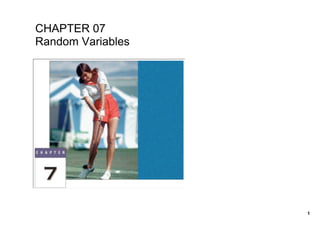
APS Chapter 07 Notes
- 7. 7.Introduction 7
- 11. Example 7.1 Getting good grades Finding discrete probabilities North Carolina State University posts the grade distributions for its courses online. Students in Statistics 101 in the fall 2003 semester received 21% A's, 43% B's, 30% C's, 5% D's, and 1% F's. Choose a Statistics 101 student at random. To “choose at random” means to give every student the same chance to be chosen. The student's grade on a fourpoint scale (with A = 4) is a random variable X. The value of X changes when we repeatedly choose students at random, but it is always one of 0, 1, 2, 3, or 4. Here is the distribution of X: The probability that the student got a B or better is the sum of the probabilities of an A and a B. In the language of random variables, P(X ≥ 3) = P(X = 3) + P(X = 4) = 0.43 + 0.21 = 0.64 11
- 14. 07.01.03: Construct the probability distribution for a discrete random variable. Example 7.2 Tossing coins Values of a random variable What is the probability distribution of the discrete random variable X that counts the number of heads in four tosses of a coin? We can derive this distribution if we make two reasonable assumptions: 1. The coin is balanced, so each toss is equally likely to give H or T. 2. The coin has no memory, so tosses are independent. The outcome of four tosses is a sequence of heads and tails such as HTTH. There are 16 possible outcomes in all. Figure 7.2 lists these outcomes along with the value of X for each outcome. The multiplication rule for independent events tells us that, for example, Each of the 16 possible outcomes similarly has probability 1/16. That is, these outcomes are equally likely. 14
- 20. Exercises p469 7.2, 3, 4, 5 20
- 23. Example 7.3 Random numbers and the uniform distribution Areas under a density curve The random number generator will spread its output uniformly across the entire interval from 0 to 1 as we allow it to generate a long sequence of numbers. The results of many trials are represented by the density curve of a uniform distribution (Figure 7.5). This density curve has height 1 over the interval from 0 to 1. The area under the density curve is 1, and the probability of any event is the area under the density curve and above the event in question. 23
- 28. Example 7.4 Cheating in school Continuous random variables Students are reluctant to report cheating by other students. A sample survey puts this question to an SRS of 400 undergraduates: “You witness two students cheating on a quiz. Do you go to the professor?” Suppose that if we could ask all undergraduates, 12% would answer “Yes.” 28
- 29. Exercises p475 #7.7, 9 29